First Case of Spinner Dolphin (Stenella longirostris) Infanticide off Reunion Island: Necropsy's Findings and Post Mortem Inter-Species Interactions- Juniper Publishers
Juniper Publishers- Journal of Oceanography
Abstract
This paper reports the first case of delphinid infanticide off Reunion Island (Indian Ocean). This event provided a rare opportunity to record almost immediate visual and acoustic behaviour in an infanticidal context. The necropsy demonstrated that calf's death was caused by traumatical injuries, most probably inflicted through purposeful violent interactions. Teeth marks found on the calf's skin would incriminate conspecifics. However, epimeletic and in particular nurturant behaviour from a mother towards her dying calf could induce superficial tooth marks as those observed here. Post mortem acoustic and behavioural observations displayed agonistic and sexual interactions from three Indo-Pacific bottlenose dolphin males towards the mother-calf pair spinner dolphin. The nature of the inter-species interaction strongly suggests that Indo-Pacific bottlenose dolphins could have caused traumatic lethal lesions on the calf to gain sexual access to a female from a smaller species.
Keywords: Infanticide; Bottlenose dolphin; Spinner dolphin; Interaction; Tooth mark; Acoustic; behavior; Indian ocean
Abbreviations: BP: Burst Pulses; IPI: Inter-Pulse Interval; LFN: Low Frequency Narrow-band calls; PRR: Pulse Repetition Rate
Introduction
Inter-specific interactions have been recorded worldwide between different sympatric cetacean species (see [1] for a review). Although the formation of mixed-species groups may generally provide benefits for at least one of the species involved, such as foraging and/or social advantages or protection against predators [2,3], aggressive and threatening behaviours that can lead to lethal attacks have also been reported [4-7].
These negative interactions have been explained by numerous hypothetic purposes: predation or competition for prey [7-13], defensive cooperative behaviour and protection of young or ill members of the group [14-16], object-orientated play as development of predatory skills or physical training [4,6,7,17,18] redirected aggression and fighting [7,19,20], social pathology or aberrant behaviour [7,9] and sexually related behaviour, harassment, sexual frustration, parental manipulation, or sexual selection [4,7,9-11,19-23].
Lethal attack, and in particular infanticide, i.e. the (direct or indirect) taking of infant life, constitutes the most striking example of aggressive behaviour. This phenomenon is widely documented in the animal kingdom, including in mammals [13] and can be inflicted by both males and females [9,13,23]. Intra and inter-specific infanticidal events have been observed among dolphin populations [5,6,24-28], although little is known about this phenomenon. The majority of infanticides recorded in the literature involves the bottlenose dolphin(Tursiops truncatus), which, according to [29], is one of the very few marine mammals known to direct lethal, non-predatory aggression to other marine mammal species. These records have been mostly reported from post mortem examinations [5,6,26] and more rarely from direct field observations [5,25,27].
Reunion (21° 07' S and 55° 32' E) is an oceanic island from the Mascarene archipelago, located about 690km east of Madagascar and 170km south-west of Mauritius Island. Two Delphinid species are mainly observed in coastal waters: the Indo-Pacific bottlenose dolphin (Tursiops aduncus) and the spinner dolphin (Stenella longirostris) [30]. Although Indo-Pacific bottlenose dolphins use preferentially shallower waters (generally <60m depth isobath) than spinner dolphins, the spatial distribution of the two species overlaps in some areas [31]. Mixed associations of spinner and Indo-Pacific bottlenose dolphins are regularly witnessed off the west coast [30], during which male bottlenose dolphins generally display sexual behaviour and harassment towards the spinner dolphins (Globice, unpub. data.).
This paper reports on the discovery of a freshly dead newborn spinner dolphin with its mother, harassed by three Indo-Pacifique bottlenose dolphins, off Saint Gilles, Reunion. This event provided a rare opportunistic occasion to put together behavioural and acoustic data on spinner/Indo-Pacific bottlenose dolphin interactions involving a dead infant, with necropsy's findings bringing evidences of infanticide.
Methodologies
Context and in situ observation
On 20th March 2016, at 1215hrs, dolphin watching operators reported the presence of a dead newborn spinner dolphin, off Saint Gilles, La Reunion. An adult individual, most probably the mother, remained close to the dead calf and a group of spinner dolphins, was observed at close distance. The mother/calf pair was closely surrounded by three Indo-Pacific bottlenose dolphins during the field observation. Underwater video from a GoPro HD Hero3 was undertaken and a 6'10" duration video clip showing dolphin behaviour was recorded.
Necropsy
The body of the dead newborn spinner dolphin was picked up from the water, transported by boat to the closest port (Saint Gilles), to be autopsied by a veterinarian from the National Stranding Network (VE). The carcass was classified as code 2 (freshly dead), according to Smithsonian Condition Codes [32] and complete necropsy, with systematic examination of all organ systems, was carried out according to standard protocols.
Underwater video analysis
The underwater video was analysed using the ad libitum sampling method, which involves reporting systematically and continuously all behavioural events observed [33]. Individual behaviours were described chronologically throughout the video session and sorted by categories (agonistic, socio-sexual or submissive) according to behaviour described in the literature (Supp. mat. S1). Particular attention was given to report on which animal was the actor or initiator of the behaviour and the recipient, when the behaviour was obviously directed towards one individual. An agonistic interaction involves "predictive signaling" in which communicative signals are produced by an initiator towards a recipient, in order to test their willingness and/or ability to escalate and fight [34,35]. Hence, agonistics behaviours are mostly characterized by visual and/or acoustic threat displays ([36] and Supp. mat. S1). These signals generally result in a set of either aggressive or submissive behaviours depending on the context and individual attributes of the opponent [37]. In case of aggressive response (i.e. defensive reaction), the recipient usually shows an escalation through a series of violent displays ([38] and Supp. mat. S1).
Still frames were extracted from the video and used to identify dolphins, based on the marks and scars of their dorsal fins, and were compared to the existing catalogues of the two species. When possible, photographs of the genital area were also extracted to identify the sex of the individuals, based on the presence of mammal slits and distance between anus and the uro-genital slit.
Acoustic data analysis
The acoustic recording was extracted from the video file, and converted into a .wav format. The GoPro audio sampling rate was 48kHz. Sound types were identified by visual and aural inspection and isolated from the spectrogram display, using Raven Lite 1.0 sound analysis software. Only whistles and burst pulses were considered for analysis. Whistles-Whistles are frequency-modulated narrow-band tonal signals, usually longer than 0.1 second in duration [39,40]. Only loud and clear whistles, not overlapping with other sound, easily detected aurally and visually on the spectrogram were selected for analysis. Time, frequency and intensity were measured manually using the cursor functions in Raven Lite 1.0.
Eleven acoustic variables were recorded for each selected whistle : beginning frequency (Hz), end frequency (Hz), minimum frequency (Hz), maximum frequency (Hz), frequency range (Hz), mean frequency (Hz), start intensity (dB), end intensity (dB), number of inflexion points (i.e. the change in contour slope, from positive to negative or vice versa), duration (s) and number of harmonics. These variables were chosen to allow for comparisons with previous studies, in an attempt to identify the species producing the sound.
Burst Pulses-Burst pulse vocalizations are energetic broadband discret packets of pulsed signals produced at rates exceeding human auditory threshold allowing temporal discrimination (inter-pulse interval<5ms [41,42]). They appear as multiple continuous harmonic bands on spectrograms [42].
Three acoustic variables were used to describe burst pulsed sounds: duration (in ms), Pulse Repetition Rate (PRR, in pulses per second or pps) and Inter Pulse Interval (IPI, in ms). The PRR, which approximates the frequency spacing between the harmonics [42], was determined by dividing the frequency range by the number of harmonics. The IPI was obtained as the inverse of the pulse repetition rate. The burst pulse emission frequency (in BP/min) was calculated by dividing the total number of burst pulses by the recording length. Occurrences of categorized behaviours and burst pulses events were counted throughout the time frame of the video/audio recording, and analysed in parallel in order to assess any possible link between behavioural and acoustic events.
Results
The spinner dolphin calf was discovered at the GPS position S 21° 3'37" and E 55° 11'53", which corresponded to a sighting located 2.5km from the west coast of Reunion, in 60m deep west coast, in an area where spinner and Indo-Pacific bottlenose waters (Figure 1). The mixed species sighting was located off the dolphin habitats overlap (Figure 1).
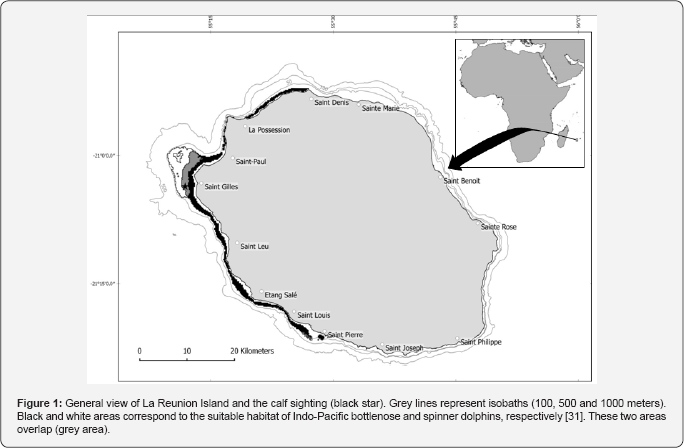
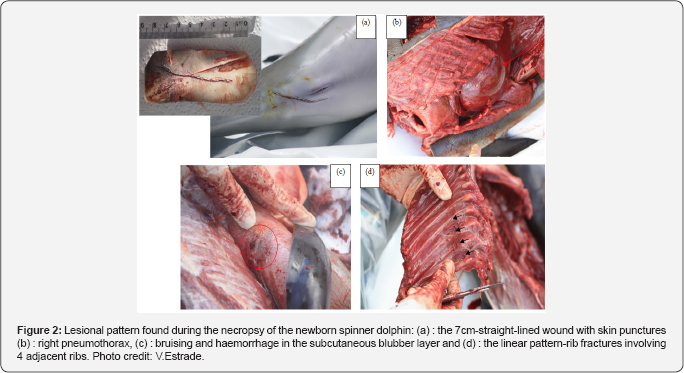
Necropsy findings
The newborn dolphin was 83cm in length and was thus estimated to be 1-1.5 months old [43]. The age of weaning of spinner dolphins being of 1-2 years [43,44], the calf was still dependent upon its mother. The absence of teeth and the presence of milk curd found in the forestomachs corroborated its physiological status. External examination of the skin showed evidence of superficial bite wounds, not deeper than the dermis (Figure 2). A 7cm-long straight-lined wound between the uro-genital slit and the anus and a 4cm-long straight-lined wound at the outer corner of the right eye exhibited numerous and evenly spaced punctures, consistent with teeth marks. The distances between each puncture ranged from 4.5 to 5.5mm. Gross exam of the two wounds showed slight cutaneous hemorrhage indicative that the heart was still beating when the injuries occurred. These wounds were thus made prior to the calf's death.
The necropsy displayed an healthy newborn with multiple ante mortem fatal injuries, all concentrated on the right thorax, caused by a severe blunt force trauma:
- bruising and haemorrhage in the subcutaneous blubber layer and underlying musculature.
- linear pattern-rib fractures, without fibrocartilagenous callus, involving 4 adjacent ribs.
- periostal haemorrhage and rupture of adjacent lung leading to pneumothorax (Figure 2).
The cause of death was determined to be a combination of shock and respiratory difficulty consequent to unilateral pneumothorax due to fracture of the rib cage. These traumatic injuries resulting from high-energy blunt impact are consistent with infanticidal behaviour.
Underwater video analysis
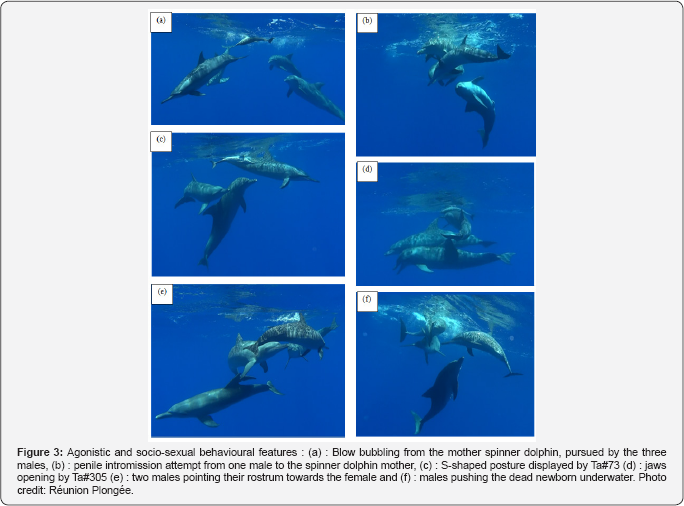
The 6'10" video recording displayed inter-specific interactions between three Indo-Pacific bottlenose dolphins and an adult spinner dolphin along with the body of the dead calf, floating at the surface (Figure 3). The adult spinner dolphin was identified as a female, and according to its behaviour and close proximity to the calf, was assumed to be its mother. Among the Indo-Pacific dolphins, one was about 2/3 the length of the two others and lighter in color and was thus assumed to be a juvenile [45]. The juvenile was identified as a male, according to the absence of mammary slits and the distance between uro-genital and anal slits, and its dorsal fin was unmarked. The two other Indo-Pacific bottlenose dolphins had been previously identified as part of an ongoing photo-identification survey (Ta#73 and Ta#305), and were known to be males, based on molecular sexing (Globice, unpublish. data).
According to the occurrence of each categorized behaviour (i.e. agonistic, socio-sexual or submissive behaviour), the video footage was divided into 5 distinct phases (Phases I to V - Table 1 & Supplement material S1). Two episodes of dynamic agonistic behaviour of the 3 male Indo-Pacific bottlenose dolphins towards the female spinner dolphin were observed, which included both a moderate phase and a climax phase (Phases I and II and Phases IV and V, respectively). Theses episodeswere separated by a period of female defensive behaviour (Phase III - Table 1 & Supplement material S1).


Phase I was characterized by moderate agonistic and weak socio-sexual behaviours. Males were indeed engaged in various visual displays, such as deliberate head and rostrum pointing towards the female, chasing, S-shaped body posturing, face- to-face positioning, open mouth threatening, defecation and bubble blowing. In addition, weak socio-sexual gestures were noticed, with physical contact attempts initiated by males on the female (ventral side-up displays, belly-to-belly contact and body rubbing attempts against the genital region of the female).
During Phase II, a threat escalation and an increase of sexual behaviours directed to the female were observed. Indeed, in addition to agonistic and socio-sexual visual displays outlined during Phase I, hiting attempts, genital inspection, "goosing" (i.e. rubbing the rostrum against the uro-genital slot) and erection were noted. Agonistic and socio-sexual behaviours appeared to be more dynamic, frequent and intrusive than those observed in Phase I. Simultaneoulsy, more frequent submissive behaviours from the female were observed during this phase compared to Phase I.
Although the female was the agonistic target of males and mostly showed submissive reactions, she also displayed agonistic behaviours to defend herself against her « aggressors » throughout Phases II and III (Table 1 & Supp. mat. S2). Indeed, during these phases she became more active and showed a provocative response to male harassment, with behaviours such as jaws opening or chasing against the males group. During Phase III, the female displayed solely agonistic behaviours leading to the temporary escape of the males group. Phase IV was characterized by moderate agonistic behaviours. Nevertheless, unlike Phase I, Phase IV displayed moderate socio- sexual gestures involving body contact such as rostrum and body rubbing against the genital region of the female, belly-to-belly contact). Phase V showed, like Phase II, strong visual agonistic displays, with rostrum and head pointing towards the female, facing, charging and pursuing, pushing the flank of the female with rostrum, jaw opening and biting attempt. By contrast with Phase II, only weak socio-sexually related behaviours directed to the mother spinner dolphin were noted, such as head rubbing of males against the female's genital region or flank rubbing. No penis display was noticed during this phase. In parallel to males agonistic behaviours escalation, more frequent and intense submissive reactions from the female were noticed during this phase.

Throughout the video, the female spinner dolphin seemed to interact with her dead neonate, turning around him, pushing him with her rostrum to the surface, carrying him to the surface on her head or rubbing her back against him. Even when she tried to escape the males' pursuit, she came back rapidly towards her motionless calf. Moreover, Indo-Pacific dolphins seemed to coercively keep the mother separated from her calf, launching themselves between the mother and her calf and forcing them apart. Additionally, when the female tried to escape or returned to her offspring, the males prevented it, trapping her or encircling her obstructively. Males only interacted with the motionless body calf during Phase II. Behaviours such as ventral side rubbing or helding the calf’s body underwater with the rostrum, displayed by Ta#73 and the juvenile, were observed. pointing their rostrum towards the female and (f): males pushing the dead newborn underwater. Photo credit: Réunion Plongée
Acoustic analysis
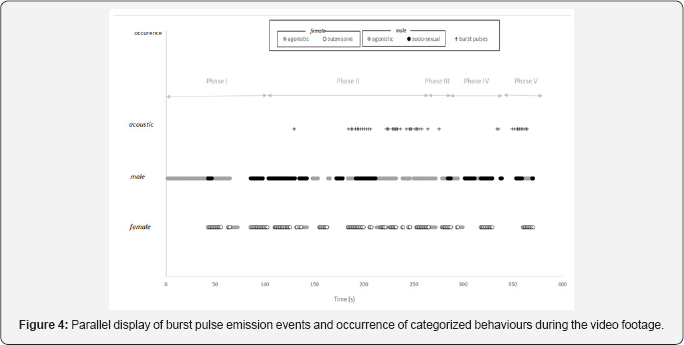
Whistles-A total of 26 whistles were aurally and visually detectable on the spectrogram including 23 whistles of high enough quality for analysis. Three types of contourwere identified (Table 2). Type I and III whistles both had sine shape; however, the type III whistle had shorter duration and displayed smaller frequency range and maximum frequency than type I. Burst Pulses-On the 66 burst pulses present on the recording, 51 were of high enough quality to be analysed. The mean duration of the burst pulses was 86.5±23.8ms (n=51) and the mean pulse repetition rate was 693±68pps (n=49). The burst pulses emission frequency differed according to the behavioural phases identified in the video footage (Table 1 and Figure 4, Supplement material S1): from 0 (no burst pulse) during Phase I (moderate agonistic and weak socio-sexual behaviours phase) to 28.2BP/min. during Phase V (strong agonistic and weak socio- sexual behaviours phase). The phases characterized by strong agonistic behaviours displayed highest burst pulse rate (Phase II and Phase V, with 14.0 and 28.2BP/min., respectively - see Table 2s and Figure 4). More specifically, a great proportion of burst pulse peak events coincided with males pointing their rostrum towards the female.
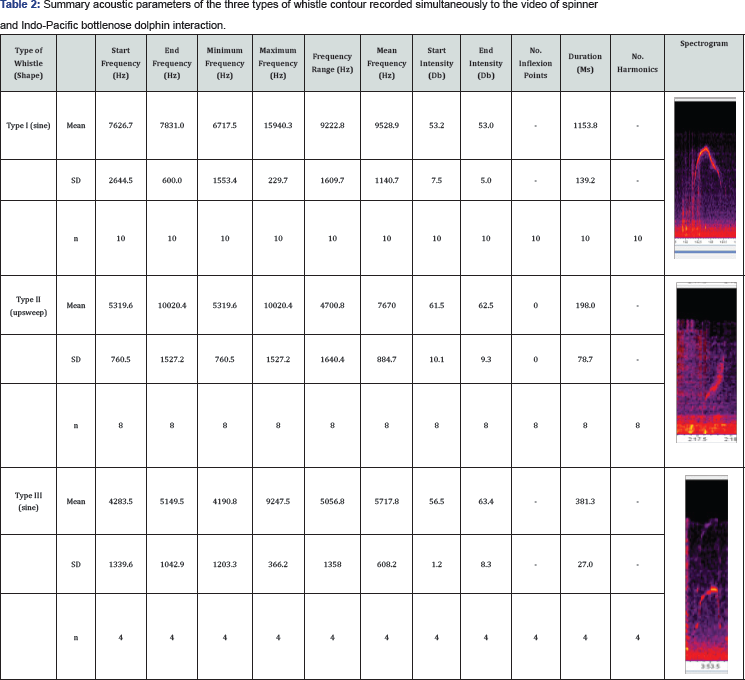
Discussion
Necropsy�s findings: evidence of infanticide
The lesions described here revealed remarkable similarities with reported evidences of infanticide: presence of external bite-wound injuries, lung lacerations, adjacent rib fractures, periostal hemorrhage and bruising [6,7,66]. However, traumatic lesions found on the newborn spinner dolphin body seem to be less extensive and severe than described in the literature. Indeed, extensive bilateral ante mortem damages were reported from bottlenose dolphin (Tursiops truncatus) calves stranded along south eastern Virginia coasts, USA [6], within the Moray Firth and adjacent coasts, Scotland [7] and on common dolphin (Delphinus delphis) calf stranded near Porthleven, Cornwall [25]. The injuries described were concentrated on the head and upper chest with multiple bone fractures or luxations (rib, vertebrae, scapula, mandibular, maxillary, skull, tympanic bulla...) and discrete soft tissue contusion or laceration (lung, liver, diaphragm.). [5] suggested that the lesional pattern found on carcasses (i.e. bilateral, multiple fractures and discrete soft tissues injuries) may be imputable to repeated trauma inflicted from multiple directions. In Reunion, lethal injuries were mainly concentrated on the right part of the thorax and it is likely that less violent attacks and/or lower number of hits were sufficient to contribute to the death of the newborn spinner dolphin, as the calf belonged to a smaller species and appeared to be younger and thus more vulnerable. Furthermore, previous studies reported lesions most likely caused by the robust bottlenose dolphin [6,7,25]. The lesser extent damages found on the carcass here could be imputable to a smaller and less robust delphinid species, such as the spinner dolphin or the Indo-Pacific bottlenose dolphin.
Dental print of bite wounds
The bite wounds found on the newborn skin showed punctures spaced by a 4.5 to 5.5mm interval. This spacing is consistent with inter-tooth interval of Stenella sp. [8,27,67], suggesting that the bites were inflicted by spinner dolphin conspecifics. Tursiops sp. shows greater inter-tooth interval, of around 9.5mm on average for T. aduncus (according to skull measurements and number of teeth data from [68]) and between 10.9 and 12.3mm forT. truncatus [8].
The presence of bite wounds caused by spinner dolphins bears witness to intra-specific interactions of spinner dolphins towards the newborn calf, but does not mean that this interaction is responsible for the death, especially as wounds were superficial. In general, the presence of rake marks on cetaceans is interpreted as the result of aggressive interaction [69,70]. However, some researchers have concluded that epimeletic behaviour can lead to rake marks [71-74]. Epimeletic or care- giving behaviour is defined as the help given from an individual to another. In particular, when attention is directed by a healthy adult, generally the mother, towards her sick, injured or dead calf, it corresponds to "nurturant" behaviour [16,75]. The behaviour displayed by the female spinner dolphin towards her dead neonate, i.e. carrying him on her head and pushing him to the surface with the rostrum, resembled that described in other papers [71-80]. Moreover, the superficial nature of the wounds suggests that they would result from manipulation of the body rather than from a bite, which would undoubtedly lead to more damages. It seems thus likely that the mother displayed an epimeletic behaviour towards her dying offspring and that she was responsible for tooth marks on his body. Because wounds found on calf's body were made ante mortem, the female might have inflicted them to the calf before death, in an attempt to help him or keep him away from the aggressors.
Inter-specific interactions: agonistic and socio/sexual behaviour of indo-pacific bottlenose dolphins
The video footage displayed agonistic, socio-sexual interactions from the three Indo-Pacific bottlenose dolphin males towards the mother spinner dolphin, around the floating calf's corpse. Aggressive behaviour, such as bite or ramming, likely to cause harm, was not observed during the 6 min recording and the moderate violence level of this recorded interaction is consistent with an agonistic display between the two species.
Nonetheless, the available video footage represented only part of the inter-specific interaction and it cannot be excluded that more aggressive behaviours occurred. Dolphin-watching operators reported that the 3 male bottlenose dolphins were observed among the group of spinner earlier in the morning, harassing a mother with calf, suggesting that the inter-specific interaction lasted for several hours.
Inter-specific negative interactions involving Tursiops genus have been widely observed [7-9,22,23,66,81-85]. In Reunion, mixed association between spinner and Indo-Pacific bottlenose dolphins are regularly witnessed (about 10% of spinner dolphins' sightings) [30]. In particular, most of these sightings involves male Indo-Pacific bottlenose dolphins (generally including Ta#305) engaged in sexual harassment of female spinner dolphins (Globice, unpub. data). Throughout the video recording, and especially during Phase II (escalation phase: strong agonistic and socio-sexual behaviours phase), the three bottlenose dolphins showed sexually related displays including gentle physical contacts (rubbing, ...), genital inspection, ventral side-up swimming and erection. This behaviour was consistent with the social structure of T. aduncus, in which males form alliances to herd females for sexual or reproduction purposes [58,86-89]. This cooperative behaviour allows males to enforce and maintain consortships with females [87] and mate through sexual coercion [86,88].
Acoustic behaviour
The presence of burst pulses in the recording session corroborates the agonistic and/or socio-sexual nature of the interaction observed. Several studies documented broadband burst pulsed sounds to be associated with social context such as aggressive/agonistic interactions among captive dolphins [38,48,49,90]. Similarly, in free-ranging dolphins, burst pulsed vocalizations have been attributed to aggressive behaviour and courtship [21,38,54,91-95]. The mean burst pulse emission frequency was 10.7 burst pulses/min, which is comparable to what we can find in the literature (8.0 burst pulses/min - [95]). Pulse repetition rate (PRR) and inter-pulse interval (IPI) did not allowed to discrimate between the two species, as values were consistent with both spinner dolphins [93,96] and bottlenose dolphins [97]. However, intensive burst pulsed sounds and increased burst pulse emission frequency were observed simultaneously with high intensity agonistic behaviour during Phases II and V, suggesting that emission frequency increased according to the excitation level [48]. More specifically, the emission of pulsed sounds coincided with males pointing their rostrum towards the female. This posture may be deliberately adopted by aggressors to ensure that maximum energy sound reaches the targeted individual [48,50]. Therefore, it is believed that burst pulse sounds were produced by male bottlenose dolphins towards the female spinner dolphin.
Similarly, comparison of acoustic parameters of each whistle contour with those found in the literature for Indo-Pacific bottlenose [50,97-101] and spinner dolphins [50,93-105] did not allow to determine which species was producing the sounds. However, the most frequent whistle recorded was type I (sine shape), which showed a distinct and repetitive contour and was produced in bouts of 1-2 whistles. The predominance, stereotypic nature and complex sine shape of this whistle type is consistent with a signature whistle [106,107]. Signature whistles are believed to convey the identity of both the caller and the group it belongs to [108-112] and are produced predominantly in circumstances of social separation, isolation or stressful situation [107,109,113-115]. As the mother spinner dolphin was kept coercively from her dead calf by the three males and probably apart from the spinner dolphins group observed nearby, it is likely that the signature whistle recorded belong to the female spinner dolphin in distress.
Possible causes of Infanticidal behaviour and species involved
Necropsy made on the freshly dead calf attributed the cause of death to blunt-force trauma, providing strong evidence for infanticide. Although the lethal interaction was not directly observed, post mortem acoustic and behavioural observations tend to be in favor of an inter-species infanticide of Indo-Pacific bottlenose dolphin on spinner dolphin. Most infanticide events reported worldwide involve bottlenose dolphins (T truncatus) either on conspecifics [6,7,95] or towards another species [25.29] , so this behaviour appear to be part of the natural habits of Tursiops sp., although never reported fromT aduncus. To our knowledge, infanticides among spinner dolphins and more generally the genus Stenella have not been reported previously The nature of the inter-species interaction between bottlenose and spinner dolphin observed right after, and probably before the calf death (as reported by operators, but not captured in video) made the interpretation of inter-specific infanticide most likely. Furthermore, the necropsy indicated that the newborn was physically healthy (no pathology, malformation or other sign of weakness reported), which tend to rule out the hypothesis that the calf was killed by conspecific because of its low probability of survival.
Given the agonistic and socio/sexual behaviour of the 3 male Indo-Pacifique bottlenose dolphins towards the mother spinner dolphin, several hypothesis could be put forward, among those that have been previously proposed to explain infanticides [5.24.25.29] Males may commit infanticide to gain sexual access to the female, both for recreational and procreative sex [6,7,24,116], especially when access to females is limited.
Infanticide may represent a male reproductive strategy whereby males kill the offspring of competing males in order to increase their own reproductive success [24,117-119]. Furthermore, when a female loses her dependent offspring prematurely, she soon becomes sexually receptive to males within a few days [24,120]. Infanticide could thus appear as a strategy to enhance reproductive success of males by inducing estrous in females that would otherwise be reproductively unavailable [121], hence allowing males to increase their breeding opportunities and ensure the transmission of their own genetic pool. Inter-specific mating has been described among cetaceans and often involvesTursiopsgenus in the wild [5,22,23,61,122,123]. To our knowledge, bottlenose X spinner dolphin hybrid has not yet been described neither in captive nor within free-ranging dolphins, althoughTursiops genus exhibits great mating behavioural plasticity relative to other species (reviewed in [124]) and has succeeded in breeding with genetically more distant species such as the Risso's dolphin, the short-finned pilot whale and the false killer whale [125-129].
Alternatively, infanticide and socio/sexual behaviour on a smaller species may have resulted from sexual frustration of male Indo-Pacific bottlenose dolphins. In Reunion, although the sex ratio is unknown, the small size of the Indo-Pacific bottlenose dolphin population Dulau et al. [30] in prep.) might lead to a relatively low availability of receptive females and males might turn to other sympatric species, such as spinner dolphins, to exercice sexual behaviour. Sexual frustration and aggressive behaviour might also be triggered by increase levels of testosterone during the breeding season [121,130,131]. Although no clear peak of reproductive activity have been identified in Reunion, the infanticide occurred in austral summer (March), thus during the breeding season reported for the species [132].
Furthermore, the presence of a juvenile among the male bottlenose dolphin could suggest that adult males were providing sexual behaviour learning to the young, thereby providing him visual displays for mimetism and mating practice, while reinforcing collaboration within male alliance [23,133,134]. In fact, an isolated female belonging to a smaller species would represent a good opportunity for young males to develop their own sexual experience and practice herding of females.
Conclusion
This is the first report of infanticide from Reunion Island and to date, it is not possible to determinate if this represents a single isolated event or if it occurs on more regular basis, yet being unobserved. In future projects, further attention should be given to aggressive interactions involving Indo- Pacific bottlenose dolphins, particularly if a calf is engaged, in order to investigate whether infanticide behaviour could have conservation implications. Indeed, infanticide events may result from stochastic variation in population sex ratio or disruption of social bonds due to anthropic disturbance and habitat alterations and even climate change [20,122,135]. In turn, this behaviour could have serious impacts on population demography and viability [135], especially on small resident cetacean population [7].
To Know More About Journal of Oceanography Please Click on: https://juniperpublishers.com/ofoaj/index.php
To Know More About Open Access Journals Publishers Please Click on: Juniper Publishers
Comments
Post a Comment